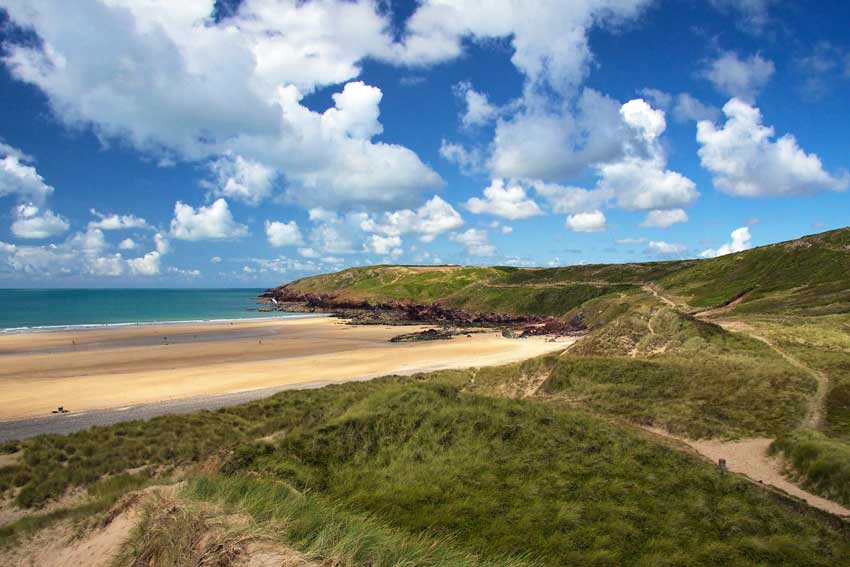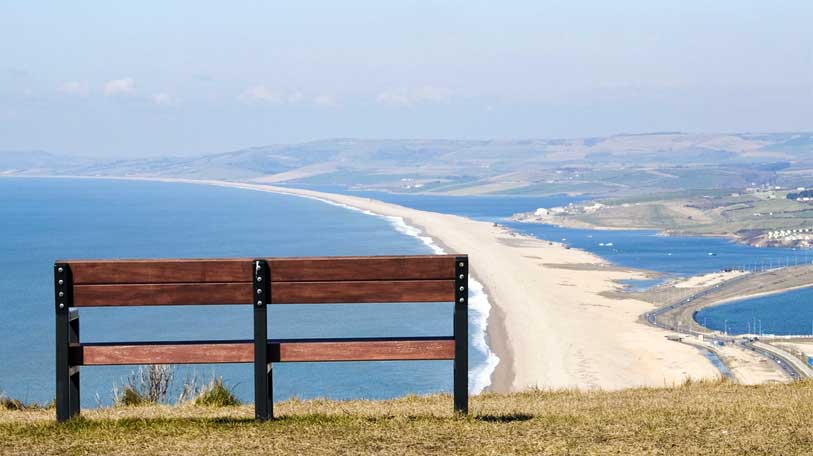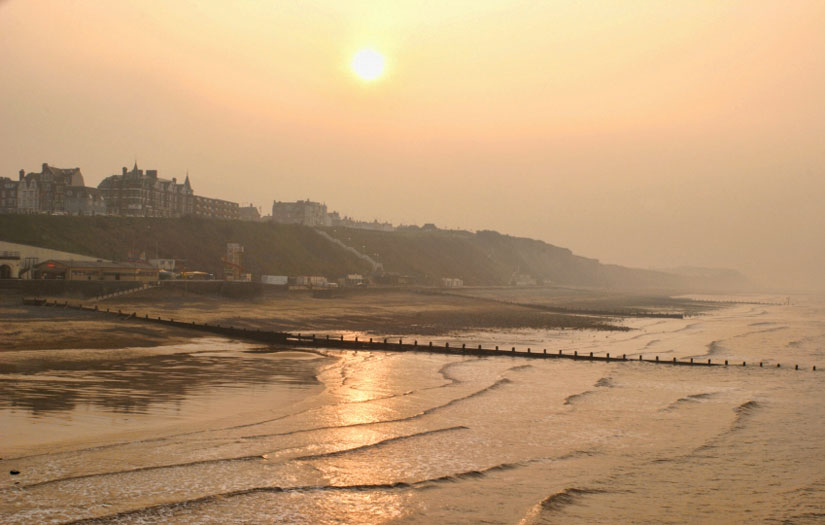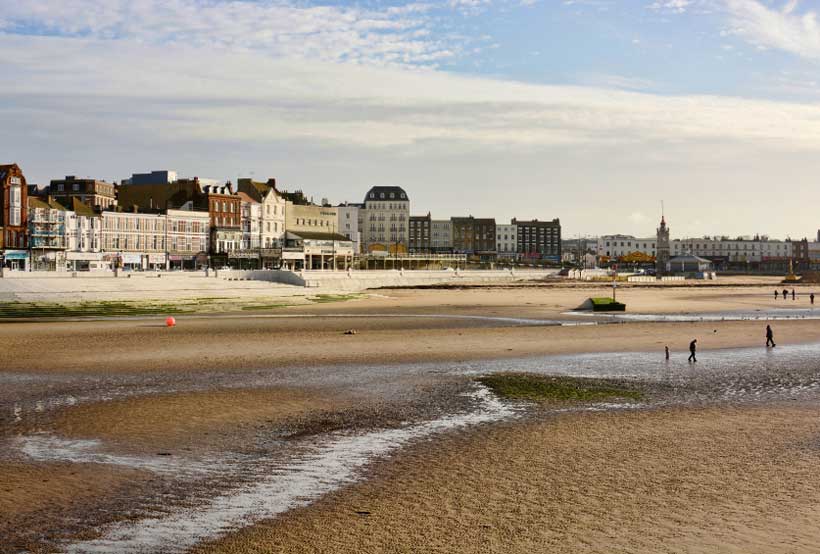UK Beach Filming Locations
- Freshwater West, Pembrokeshire
- Seven Sisters, East Sussex
- Kynance Cove, Cornwall
- Marloes Sands, Pembrokeshire
- St Catherine's Island (Castle Beach), Tenby
- Porthgwarra, Cornwall
- Durdle Door, Dorset
- Barry Island, Glamorgan
- West Sands, St Andrews, Fife
- West Bay, Dorset
- Holkham Beach, Norfolk
- Chesil Beach, Dorset
- Robin Hoodâs Bay, North Yorkshire
- Brighton, East Sussex
- Camusdarach Beach, Near Morar
- Lyme Regis, Dorset
- Saunton Sands, Devon
- Camber Sands, East Sussex
- Penbryn Beach, West Wales
- Shingle Street, Suffolk
- Cromer, Norfolk
- Red Point Beach, Wester Ross
- Margate, Kent
- Southerndown Beach, South Wales
- Holywell Bay, Cornwall
Given its variety and beauty it is no surprise the UK coastline has featured as a filming location for a myriad of TV shows and movies. Our beaches offer a range of backdrops from completely natural to characterful fishing villages or Victorian seafronts ideal for period dramas. British beaches have even doubled as 16th century Mexico and tropical Korea, not to mention outer space!
Many big name films have used UK beaches as locations - Harry Potter, James Bond and fair few Hollywood blockbusters have all been filmed along our coast. A handful of these still draw a steady stream of fans making the pilgrimage to see these silver screen stunners first hand.
Freshwater West, Pembrokeshire

©mariosp and licensed for reuse under this licence
Freshwater West was used as a backdrop in the final Harry Potter film - the Deathly Hallows: Part 2. Filmed in 2011 much of the action centres around "Shell Cottage" which was located in the dunes behind the beach. The exquisitely detailed cottage was constructed for the film and taken down after filming without a trace left behind.
The beach at Freshwater was also the site of Dobby the house elf's death in Harry Potter and the Deathly Hallows: Part One. Ever since it has become something of a shrine for fans with a memorial constructed out of rocks. At one point the National Trust were asking fans not to leave socks and trinkets at the shrine due to environmental concerns.
Freshwater West was also used as a location in Ridley Scott’s 2009 Robin Hood. Over 150 horses and 600 extras were used in an epic battle scene along the water's edge.
Seven Sisters, East Sussex

Known as the Seven Sisters these chalk cliffs tower over the English Channel between Cuckmere Haven and Birling Gap. Whilst it can't be denied the landscape here is pretty dramatic, it seems the chief appeal to film-makers is as a stand-in for the famous White Cliffs of Dover.
The advantages over the Cliffs of Dover are twofold; firstly there is no modern development in view and secondly they are whiter! Yes, due to coastal protection around dover the cliffs have apparently started turning green with vegetation.
Coincidentally, the Seven Sisters have been used as a backdrop in both Harry Potter and a Robin Hood film. However, this Robin Hood was Kevin Costner's 1991 Prince of Thieves version and the Harry Potter film was the Goblet of Fire.
Kynance Cove, Cornwall

Kynance Cove is without doubt one of Cornwall's most unique (and Instagrammed) places. Here turquoise water meets a collection of curiously-shaped rock formations and islands.
Despite its relatively out-of-the-way location on the Lizard Peninsula, Kynance Cove has been used as a location for a number of film and TV series over the decades.
In recent years the little cove has surged in popularity, largely since it appeared in the 2015 adaptation of Poldark. Kynance features as "Nampara Cove" and was used as a backdrop for some of the clifftop riding scenes.
More recently the beach here was used for filming the Game of Thrones spin off, House of the Dragon.
Marloes Sands, Pembrokeshire

©David Evans and licensed for reuse under this licence
Not far along the Pembroke coast from Freshwater West is Marloes Sands. A wide sweep of sand backed by sheer cliffs and dotted with jagged rock formations, this beach is not without a certain drama.
Beautiful from all angles and slightly menacing from some the latter comes into play for the beach's part in the 2012 film, Snow White and the Huntsman. Starring Charlize Theron, Kristen Stewart and Chris Hemsworth this dark fantasy used Marloes Sands as the scene for an epic battle featuring over a hundred horses, full medieval armour and a huge CGI castle perched on Gateholm Island.
St Catherine's Island (Castle Beach), Tenby

The harbour town of Tenby in south west Wales is well known for its beautiful sandy beaches and colourful seafront townhouses. Set less than a hundred metres off the sands of Castle Beach is the rugged little island of St Catherines. Atop this imposing lump of rock is a rather austere looking fortress.
Built as to stand guard over Carmarthen Bay, the sturdy Napoleonic fort only served for 30 years before being sold to a wealthy local businessman. Once opulently decked as some sort of extravagant hunting lodge the fort eventually fell into disrepair before, somewhat ironically, becoming a Zoo in the 1960s.
Now vacant, the spectacular and dramatic location was put to good use in 2016 for filming of the final episode of the Sherlock TV series. In the episode (The Final Problem) you would not know the island was barely a stone's throw from the shore. The 'remote' fortress became Sherrinford - a maximum security prison housing Sherlock's psychopathic sister.
Porthgwarra, Cornwall

Until relatively recently the tiny beach at Porthgwarra was virtually unknown outside of West Cornwall. Back in the 1800s the sheltered cove was home to a small fishing community but those days are long gone. Situated between Land's End and Porthcurno, Porthgwarra was something of a secret, best known for the tunnels cut into the rocks by the slipway and as a popular spot for twitchers.
All that changed with a particularly memorable scene from the 2015 Poldark TV series. The scene in question features Ross Poldark taking a skinny dip off the beach whilst love interest Demelza looks on from the cliffs above.
Ever since Porthgwarra has been firmly on the map with many a visitor hoping the might catch a glimpse of the handsome Ross Poldark taking a dip!
Durdle Door, Dorset

There are very few places on the British coast as iconic and instantly recognisable as Durdle Door. One of the star attractions on the Jurassic Coast the natural limestone arch really is a geological wonder.
While the beach attracts photographers by the bus load it isn't quite as obvious a film location. Given its iconic nature and instantly recognisable form it can't really pretend to be anywhere else.
Of course this isn't an issue if your film is set in Dorset, so the location managers for Thomas Hardy's Far From the Madding Crowd were very much up for using Durdle Door. In fact they did so twice; once for the 1967 version and again for Thomas Vinterberg's 2015 adaptation.
Barry Island, Glamorgan
West Sands, St Andrews, Fife

©Christine Rondeau
The wide sweep of beach in St Andrews, backed by the world famous golf course, became the backdrop for one of the most iconic opening scenes to any British film.
In 1981 a group of white clad, barefooted runners were filmed running along West Sands. When the footage hit the big screen that year it was in slow motion and backed by the now equally famous soundtrack by Vangelis.
The film was Chariots of Fire which went on to win four Oscars. The storyline chronicles the struggle of two athletes, Eric Liddell and Harold Abrahams, in preparation for the 1924 Olympics.
Whilst the film is based on a true story the beach running scene actually took place in Broadstairs in Kent. However, most of the filming was based in Scotland so the logistics rules out Kent.
West Bay, Dorset

Back to Dorset's Jurassic Coast for this one. West Bay is a small harbour town at the mouth of the River Brit just to the south of Bridport. In fact the harbour here is named Bridport Harbour.
To the east of the harbour lies a good length of shingle and sand beach backed by towering golden cliffs. In fact this stretch of coast is home to Golden Cap, the highest sea cliff on the south coast.
Such a backdrop can certainly provide some scale and drama, and this was put to good use in the much-acclaimed crime-drama TV series Broadchurch.
Starring Olivia Coleman and David Tennant, the series' writer described Broadchurch as "a love letter to the scenery of the Jurassic Coast". Much of the filming takes place in and around West Bay.
Holkham Beach, Norfolk

©"Zorba the Geek"
Possibly the finest beach in Norfolk, this massive stretch of golden sand is backed by dunes and pine forest and very little else. Untouched by developers Holkham beach not only has a beautiful natural appeal but it is timeless.
Add to this the fabulous, Palladian Holkham Hall and you have the perfect location for a period drama involving Gwyneth Paltrow being washed up on a beach. Despite the beach supposedly being in Virginia the 1999 film, Shakespeare in Love, picked up 7 Oscars.
But this isn't the only big budget, big name film to be made on the sands of Holkham. In 1976 scenes from The Eagle Has Landed were filmed here. Set during World War II, the plot centres on Nazi special services landing at Holkham in an attempt to kidnap Churchill.
Along with a number of other films and TV series one of the most recent blockbusters to be filmed on this stretch of Norfolk coast was the 2018 sci-fi film Annihilation. Sadly, if you are hoping to see the lighthouse from the film you won't - it was CGI.
Chesil Beach, Dorset

Yes, back to Dorset's spectacular and wonderfully varied coastline. This time to Chesil Beach, a somewhat bizarre geological formation. The beach here consists of a massive, near-straight bank of rounded pebbles which runs for a length of 18 miles (29 km) between West Bay and the Isle of Portland.
So, given Chesil Beach's uniqueness it is no surprise the makers of Ian McEwan's On Chesil Beach chose it as a filming location. The story of a newly wed couple's struggle is reflected in the brooding overcast gloom and endless emptiness of the beach.
Other films have used the beach and Fleet Lagoon behind for a location including Chitty Chitty Bang Bang in 1968 and the Dam Busters in 1955. This is where the bouncing bomb prototypes were first tested in World War II.
Robin Hood’s Bay, North Yorkshire

We've already mentioned two Robin Hood films so you'd be forgiven for assuming that Yorkshire's Robin Hood's Bay would be a dead cert for filming one or the other. However, it seems the name alone was not enough to convince location managers.
Set on the edge of the North Yorkshire Moors, Robin Hood's Bay is a particularly picturesque fishing village clinging to the steep cliffs of the bay. The timeless appeal of the village's cobbled streets and quaint cottages, along with stunning coastal scenery made it a great choice for the 2017 film Phantom Threads.
Starring Daniel Day Lewis the film is a the tale of a romance between a celebrated fashion designer and a young waitress with something of a dark twist.
Brighton, East Sussex

©Hert Niks (Pixabay)
As the quintessential British seaside town, and located a quick hop from London it is easy to see why Brighton has been a popular choice with filmmakers over the years.
Whilst Brighton has Victorian seaside in abundance it has rarely been used as a generic location. Basically the town is too identifiable with its numerous iconic landmarks. The pier, Pavillion, Grand Hotel etc are all to well known to be anywhere else. However, this doesn't seem to have been a problem as being "London-on-Sea" means the town features in plenty of scripts as itself.
One of the earliest well-known films to be shot (and later remade) in Brighton is of course Brighton Rock. This 1947 classic was filmed entirely in the Brighton and takes in much of the town.
Perhaps the most celebrated of all films to use Brighton as a location was the 1979 Mod epic Quadrophenia. At the heart of the film is the bank holiday weekend centred around Brighton's seafront.
Camusdarach Beach, Near Morar

©Richard Webb
The Highlands and Islands of Scotland are full of beautiful white sand beaches and Camusdarach beach is no exception. Part of the Silvery Sands of Morar this crescent of white sand looks out of clear, blue waters towards the jagged peaks of Skye and Rum.
Of all the beaches to choose from the locations team from the popular 1983 film Local Hero decided on Camusdarach, despite it being around 175 miles from were the majority of the village scenes were filmed.
In the film Camusdarach is named "Ben's Beach" after the old beachcomber who owns and lives in a hut on the beach. Ben refuses to sell the beach to the big oil company who want to turn it into a refinery - which, given the beauty of the place, probably wouldn't even have been allowed 40 add years ago!
Lyme Regis, Dorset

Last one in Dorset, I promise! Although I could find plenty more...
With its coastal charms and well-preserved historic streets Lyme Regis has been used as a film location on numerous occasions over the years. The film which really put the town on the movie map was The French Lieutenant's Woman, filmed back in 1980.
Lyme Regis was home to the author John Fowles, and the film makes dramatic use of 'the Cobb', the old harbour wall, with the famous shot of Meryl Streep walking to the end wearing a hooded cloak.
More recently further period dramas and biopics have been filmed in Lyme Regis. Ammonite (2020) tells the true story of the acclaimed but overlooked paleontologist Mary Anning.
In 2022 a Netflix version of Jane Austen's Persuasion was filmed largely in and around the town. Although this version has a modern take on the original novel it includes scenes in locations such as the Cobb just as the author had envisaged.
Most recently Lyme Regis has been used for filming Warner Bros' Wonka. The spin off from Charlie and the Chocolate Factory tells the story of Roald Dahl's colourful character, Willy Wonka.
Saunton Sands, Devon

At low tide North Devon's Saunton Sands is a vast expanse of flat sand. In fact there is so much space here that the military have been known to land one of their largest planes here on occasion.
A popular spot for surfers and beachgoers in general Saunton Sands has also caught the eye of a number of TV and film directors over the years, including some very big budget movies.
One of the earliest films shot here was the 1946 Powell and Pressburger film A Matter of Life and Death where a pilot, played by David Niven, wakes up (surprisingly) alive on a beach after jumping from his Lancaster bomber.
Most recently, and at the upper end of the budget scale was the DC comics blockbuster Aquaman and the Lost Kingdom. Filmed in 2023 the film brought the likes of Jason Momoa and Ben Affleck to the North Devon beach.
This wasn't the first time Hollywood royalty had filmed at Saunton Sands. In 2014 Tom Cruise was here for the filming of Edge of Tomorrow.
Saunton Sands rarely gets to be itself in films and The Guernsey Literary and Potato Peel Pie Society was no exception. The clue's in the name with North Devon doubling for the Channel Island. In the film, set in WWII a Douglas Dakota plane takes off and lands on the beach. Seems to be something of a theme here...
Camber Sands, East Sussex

One of the south coast's finest beaches, Camber Sands is something of a surprise for this corner of England as (yes, the clue is in the name) it's sandy! Now, it is possible there are sandy beaches that are slightly closer / easier to get to from London, but none of them have the relatively untouched, wild backdrop of Camber Sands.
Much of the beach is backed by dunes which largely obscure the golf course beyond. With even more sand on show at low tide Camber Sands was used to stand in for the beaches of Dunkirk in the 1958 film of that name. The actual Dunkirk is only around 30 miles across the Channel.
One of the most acclaimed films to feature the beach over recent years was the 2014 biopic of Stephen Hawking, The Theory of Everything. Also made that year was the World War II film The Monuments Men where Camber Sands again stands in for the beaches of Normandy.
Just a year before another fairly sizeable production used Camber Sands as a stand in for somewhere else. This time it was Margate beach in The Invisible Woman, a film based on Charles Dickens and his affair with Nelly Ternan, who was not actually invisible at all!
Maybe the most bizarre use of Camber Sands in film was in the 1967 Follow That Camel, the 14th of the Carry On films. In the film the beach was supposed to be the Sahara desert, although in reality filming had to be halted a number of times as there was snow on the ground!
Penbryn Beach, West Wales

Widely regarded as one of the best beaches in Ceredigion, Penbryn is a beautiful stretch of golden sand that is now under the stewardship of the National Trust.
With its relatively remote location looking out over Cardigan Bay, you can imagine why it might be suitable for a film location with very few visible giveaways as to where you actually are.
I'm guessing this was the rationale back in 2002 when Penbryn beach was used as a stand in for North Korea in the 20th Bond film, Die Another Day. Having never visited North Korea, I couldn't say whether there is any resemblance, but then again I guess this goes for over 99% of those who have seen the film!
In the film the beach is used for the final love scene between Halle Berry and Pierce Brosnan. The opening scene was actually filmed on a different UK beach, but we'll get to that in a minute.
Shingle Street, Suffolk

©Amanda Slater
The aptly-named Suffolk village of Shingle Street is somewhat off-the-beaten-track. This is a strangely eerie spot on the coast and has something of an air of mystery about it.
Back in World War II tales of an attempted German invasion being thwarted on the beach here were circulated to boost morale. It is suggested that it never happened. All the same the village was evacuated and remained empty for almost a decade.
It is perhaps Shingle Street's slightly odd yet picturesque nature that has drawn at least a couple of film crews to this village on a beach over the years. In 2017 it featured in Ian McEwan's The Child in Time which starred Benedict Cumberbatch.
The best-known appearance of Shingle Street on the big screen though was in the 2019 movie Yesterday. This is where Jack visits the cottage of John Lennon who had lived a different life with the Beatles having never happened.
Cromer, Norfolk

Once known as the 'Gem of the Norfolk Coast' Cromer is a traditional seaside town that flourished during the Victorian and Edwardian era. The town sits perched on cliffs above the wide sandy beach which is home to one of the best preserved piers in the country.
Cromer has moved with the times and does a good job of balancing its traditional attractions with the modern. This has helped it attract a number of films over the years, most of which feature that iconic pier.
Probably the biggest grossing film to be shot on Cromer Pier was Alan Partridge : Alpha Papa back in 2013. Here the pier is the scene of the dramatic shootout after a low speed car chase. Given Alan Partridge is based in Norwich, it is safe to assume Cromer plays itself here.
In other films the pier is more of a generic Victorian pier. For example the 2015 TV series Partners in Crime. The pier end theatre has also been used in a couple of productions including the 2011 In Love with Alma Cogan and the 1972 budget horror The Flesh and Blood Show.
Red Point Beach, Wester Ross

©Stuart Wilding
Remote Red Point beach is one of two beaches located either side of a bracken-covered headland. Although the name refers to the point the sands here definitely have a ruddy hue. Set on the convoluted west coast of the Scottish Highlands the beach has views to the Isle of Skye and a backdrop of snow-capped mountains.
The beach features in the 2014 comedy, What We Did on Our Holiday. The film follows events as a dysfunctional family travels to Scotland for the grandfather's 75th birthday on his rural estate.
Red Point is used for the day out at the beach scene and also the final scenes of the film.
Margate, Kent

Southerndown Beach, South Wales

Also known as Dunraven Bay, Southerndown Beach lies about halfway between Cardiff and Swansea on the South Welsh coast. Despite not being far from anywhere this place has a really remote, wild feel to it. Maybe for this reason it has been used as a filming location on several occasions.
Probably the best known TV production to use Dunraven Bay is Doctor Who, with a number of episodes featuring the beach. In the TV series the beach becomes Bad Wolf Bay in Norway which appears in the Doomsday and Journey's End episodes.
Southerndown also features in the Merlin TV series. Here it appears at the end of The Labyrinth of Gedref. Sherlock fans may also recognise the beach from The Final Problem where a helicopter carrying Moriarty lands here.
Holywell Bay, Cornwall

Holywell Bay is a big sandy stretch a few miles to the west of Newquay. Managed by the National Trust the coastline here remains undeveloped with only the extensive sand dunes visible from the beach. Lying just off the coast of Holywell are a pair of massive rocks known as Gull Rocks. These very much add to the character and drama of the beach, something that obviously hasn't been lost on Cornwall's location managers.
The beach here has been used as a stand in for various locations. Like Penbryn in Wales, Holywell was used in the 2002 James Bond film Die Another Day where it was supposed to be North Korea. In this opening scene for the film Pierce Brosnan arrives by surfboard having just ridden a monster wave.
More recently Holywell Bay featured in a couple of episodes of the Game of Thrones spin off, House of the Dragon. The bay is used as the beach below High Tide Castle (St Michael's Mount) in Driftmark and also forms the backdrop of the infamous Targaryen love scene.
It probably won't surprise you to know the beach also appears a number of times in Poldark where it becomes Warleggan's Beach.